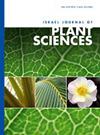病毒新菌株JLCuGV感染麻疯树节外植体的体外研究及分生组织培养生产种植材料
IF 0.9
4区 生物学
Q4 PLANT SCIENCES
引用次数: 0
摘要
麻疯树是一种重要的生物柴油植物,其种子含油量为27-40%。病毒感染对植物生长和产量产生不利影响。本研究是利用分生组织培养从病毒感染的植物中培养植株。利用结节外植体培养,研究了新毒株麻疯树卷曲古吉拉特病毒(JLCuGV)造成的培养损失。在添加6-苄基氨基嘌呤(BAP)和吲哚-3-乙酸(IAA)的MS培养基上,病毒感染的外植体的芽诱导率(48.3±15.1%)较差。在节形外植体的继代培养中发现了严重的培养损失。在添加0.5 mg/L噻地唑龙(TDZ)的Murashige和Skoog (MS)培养基上,顶端分生组织(MC)的芽诱导率最高(86.3±12.5%)。在含1.0 mg/L BAP、1.5 mg/L IAA和0.5 mg/L赤霉素(GA3)的培养基中,芽数为9.9±1.7个,芽长为5.2±0.5 cm时,芽的增殖和伸长效果最好。有趣的是,生根率不受病毒感染的影响。病毒感染和分生组织培养的芽生根良好,生根率无显著差异。研究结果表明,用分生组织外植体可以从受病毒感染的植物中产生种植材料,但用节段外植体则难以产生。本文章由计算机程序翻译,如有差异,请以英文原文为准。
In vitro study of virus new strain JLCuGV infected nodal explants and production of planting material through meristem culture from virus-infected Jatropha curcas plants
Jatropha curcas is an important biodiesel plant as its seed contains 27–40% oil. The virus infection causes adverse effects on plant growth, and yield. The present study was carried out to develop plantlets from virus-infected plants using meristematic cultures. Cultures were also raised using nodal explant to figure out culture loss caused by the new strain of Jatropha leaf curl Gujarat virus (JLCuGV). Poor (48.3 ± 15.1 %) shoot bud induction was noted in virus-infected explants on MS medium supplemented with 6-benzylaminopurine (BAP) and Indole-3-acetic acid (IAA). Severe culture loss was noted upon subsequent sub-cultures of nodal explants. Apical meristem (MC) developed the highest (86.3 ± 12.5 %) shoot bud induction on Murashige and Skoog (MS) medium supplemented with 0.5 mg/L Thidiazuron (TDZ). Best results in shoot proliferation and elongation were achieved on 1.0 mg/L BAP, 1.5 mg/L IAA and 0.5 mg/L Gibberellic acid (GA3) containing medium with 9.9 ± 1.7 number of shoot buds of 5.2 ± 0.5 cm shoot length. It was interesting to note that the rooting percentage was not affected by virus infection. Shoots obtained from virus-infected and meristem cultures rooted well without any significant difference in rooting percentage. It was known by the study that the generation of planting material from virus-infected plants was possible with meristem explants but recalcitrant with nodal explants.
求助全文
通过发布文献求助,成功后即可免费获取论文全文。
去求助
来源期刊

Israel Journal of Plant Sciences
生物-植物科学
CiteScore
1.90
自引率
0.00%
发文量
17
审稿时长
>12 weeks
期刊介绍:
The Israel Journal of Plant Sciences is an international journal of extensive scope that publishes special issues dealing with all aspects of plant sciences, including but not limited to: physiology, cell biology, development, botany, genetic
 求助内容:
求助内容: 应助结果提醒方式:
应助结果提醒方式:


